Input interpretation

trichlorofluoromethane
Chemical names and formulas
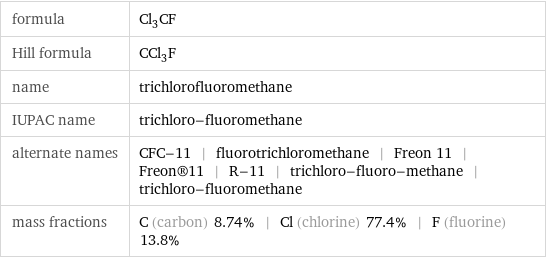
formula | Cl_3CF Hill formula | CCl_3F name | trichlorofluoromethane IUPAC name | trichloro-fluoromethane alternate names | CFC-11 | fluorotrichloromethane | Freon 11 | Freon®11 | R-11 | trichloro-fluoro-methane | trichloro-fluoromethane mass fractions | C (carbon) 8.74% | Cl (chlorine) 77.4% | F (fluorine) 13.8%
Lewis structure
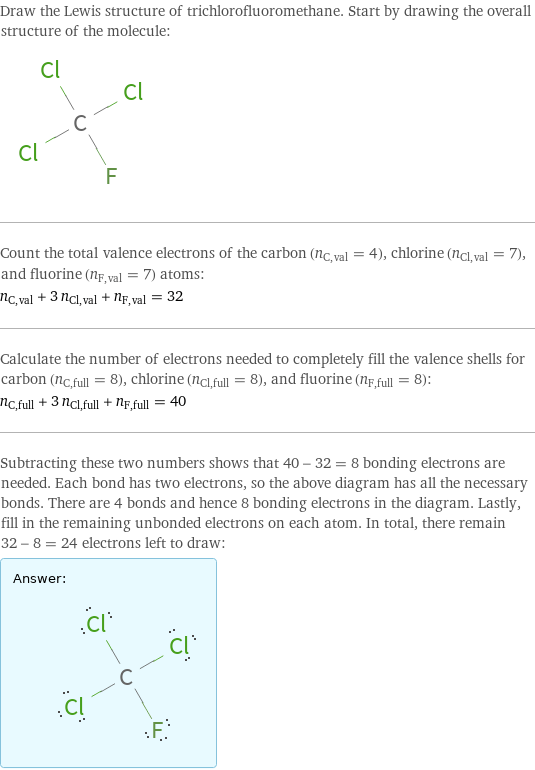
Draw the Lewis structure of trichlorofluoromethane. Start by drawing the overall structure of the molecule: Count the total valence electrons of the carbon (n_C, val = 4), chlorine (n_Cl, val = 7), and fluorine (n_F, val = 7) atoms: n_C, val + 3 n_Cl, val + n_F, val = 32 Calculate the number of electrons needed to completely fill the valence shells for carbon (n_C, full = 8), chlorine (n_Cl, full = 8), and fluorine (n_F, full = 8): n_C, full + 3 n_Cl, full + n_F, full = 40 Subtracting these two numbers shows that 40 - 32 = 8 bonding electrons are needed. Each bond has two electrons, so the above diagram has all the necessary bonds. There are 4 bonds and hence 8 bonding electrons in the diagram. Lastly, fill in the remaining unbonded electrons on each atom. In total, there remain 32 - 8 = 24 electrons left to draw: Answer: | |
3D structure
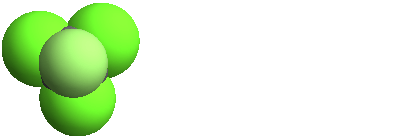
3D structure
Basic properties
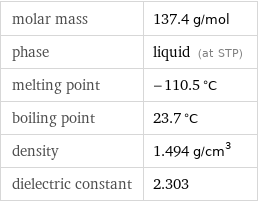
molar mass | 137.4 g/mol phase | liquid (at STP) melting point | -110.5 °C boiling point | 23.7 °C density | 1.494 g/cm^3 dielectric constant | 2.303
Liquid properties (at STP)
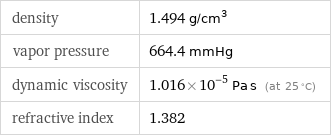
density | 1.494 g/cm^3 vapor pressure | 664.4 mmHg dynamic viscosity | 1.016×10^-5 Pa s (at 25 °C) refractive index | 1.382
Units

Thermodynamic properties

specific heat capacity c_p | gas | 5.686 J/(g K) | liquid | 0.8853 J/(g K) molar heat capacity c_p | gas | 781 J/(mol K) | liquid | 121.6 J/(mol K) specific free energy of formation Δ_fG° | liquid | -1.724 kJ/g molar free energy of formation Δ_fG° | liquid | -236.8 kJ/mol molar heat of vaporization | 25.1 kJ/mol | specific heat of vaporization | 0.1827 kJ/g | molar heat of fusion | 6.89 kJ/mol | specific heat of fusion | 0.0502 kJ/g | (at STP)
Phase diagram

Phase diagram
Units

Chemical identifiers
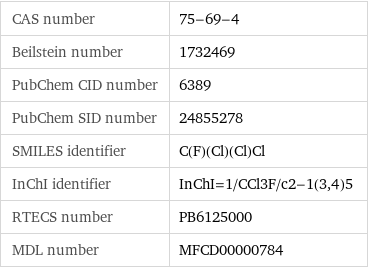
CAS number | 75-69-4 Beilstein number | 1732469 PubChem CID number | 6389 PubChem SID number | 24855278 SMILES identifier | C(F)(Cl)(Cl)Cl InChI identifier | InChI=1/CCl3F/c2-1(3, 4)5 RTECS number | PB6125000 MDL number | MFCD00000784
Toxicity properties
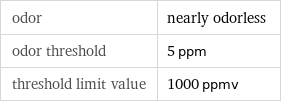
odor | nearly odorless odor threshold | 5 ppm threshold limit value | 1000 ppmv
Units
